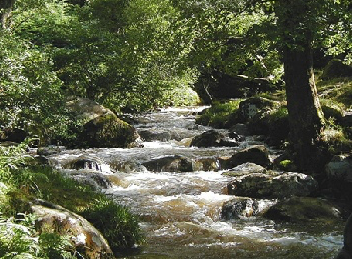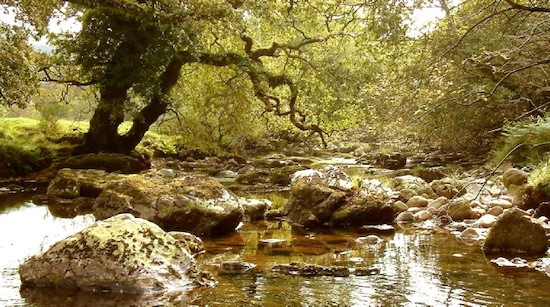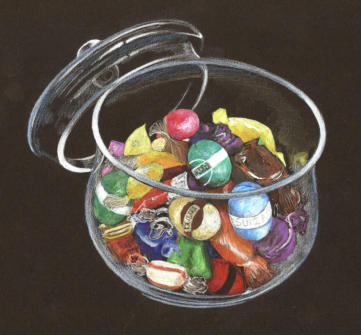Line and Wash - watercolour pencil tutorial
This exercise demonstrates the line and wash technique using watercolour pencils, a tutorial with a special focus on hot pressed watercolour paper.
Follow along with Peter as he shares his expertise using watercolor pencils from the Staedtler Karat box of 36 colours.
The chosen 270gsm HP paper called Bamboo, is from Hahnemuhle, a prestigious German manufacturer. This eco-conscious surface is composed of 90% bamboo fibres.
Downloads
Download the original outline drawing, source photo and PDF instructions.
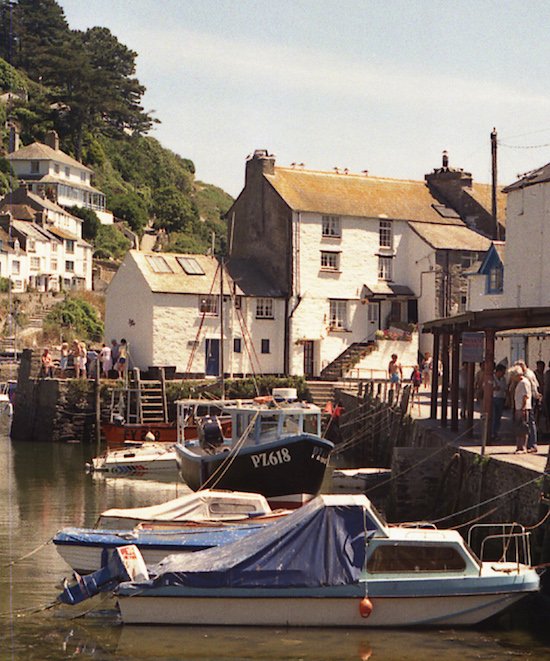 The source photo which was used as a reference
The source photo which was used as a referenceAlternative pencil brands
- Derwent Inktense feature a high-pigment, ink-based core.
- The lower pigment Caran d'Ache Supracolour and Derwent Watercolour pencils, yield more subtle hues when wet.
- Albrecht Durer watercolour pencils from Faber Castell offer a true watercolour feel.
- Performance varies across different brands.
Keep these tips in mind:
- Use light pressure: Apply a gentle touch to avoid creating harsh lines that resist blending and become embedded in the paper's texture.
- Don't sharpen your pencil: Keep your pencil point flat to the paper when adding the dry colour to avoid indenting.
- Protect lighter areas: Apply a protective layer of white to safeguard regions that you want to keep light.
Line and Wash project- Making a start
For the first stage, definite lines on the paper don't matter as you are simulating foliage and need a dappled effect.
Use a small, light, scribbling stroke with your greens for the trees. Incorporate sepia with the mid green in the top for a darker green area. Work down to more of a shading type stroke for the mixture of mid green and olive green in the lower areas of the background grass and the nearer hillside.
Build up layers of greens and some gold and shade over the top to get a good depth of pigment.
Use a layer of white to protect areas you want to be lighter coloured than the pencils normally allow, for example the roofs and shadowed house walls, then add your second colour layer on top. This will give a more pastel effect and the white will reduce the amount of the darker colour that the paper will take.
When shading walls (white and pale grey) keep your strokes as smooth as possible and work in the direction the wall runs - either vertical or horizontal but not diagonal.
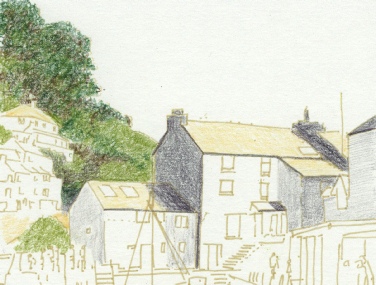
If you have an Ivory or Light Cream in your colour range, this will warm up walls in sunlight. There is a perfect one in the Faber Castell Albrecht Durer and Caran d'Ache Supracolour ranges, but not in the small Staedtler set we are using.
The colours will be quite a lot lighter on the paper as you put them down dry, and will develop more depth and strength when you add water later.
If you are new to watercolour pencils, don't put down too much colour until you know how your brand of pencils will perform. Better two coats of dry colour than too much!
Step 2 using watercolour pencils dry

Moving on down the page, I shaded in the far harbour wall with a first layer of light olive green at the top and brown (77) further down, followed by a layer of dark grey (8) over all. I was careful to leave little strips of light where the steps are. I then worked on round the walls, adding more brown to the mix as we came nearer the viewer and again left strips of white for the tie up ropes.
The fish market shed was then worked, making sure space was left for the standing people. Next I put in the red flowers in the far window boxes at the top of the steps and the standing woman in the sunlight along with the red float on the nearby boat.
Now to work on the blues.
You will see how I have used three of the blues available to me. Choosing a light blue (37) for the boat cover undercoat ad dark blue for the shadowed top coming down in lines. I have added some dark grey in the deep shadow of the covered side window.
I need to take a decision over colours for the other boats and whilst there are a lot of other colours available in the box, I am going to stay with the blue set.
For the number on the PZ618 registered fishing boat you can use a soft white wax pencil to go over the numbers and letter before you do the main hull. This will act as a partial resist when water is added later. Your numbers won't stay white, but will still be visible.
The main boat hull is completed in black. And the water done with the ochre pencil in horizontal lines. I have put the rear (stern) of the middle launch in a bright yellow as I was going to use the Yellow with blue on the boat cover of that one. That is about it for now.
The result is shown in scan 2 and you will see that we have two options at this point.
The paper is showing the white flecks it usually does at this stage, where the pigment has not yet hit the little valleys in the paper surface. We can continue with dry point pencils and work successive layers over the top of what is shown below, or - if we used aquarelles, we can use a damp brush to wash in the aquarelle pencil pigment into the paper and work on with dry colour afterwards.
The first option will give us a paler, more natural, result, the second a more vivid set of colours with more contrast. Lower pigment levels in the pencil will give a less marked leap in colour levels.
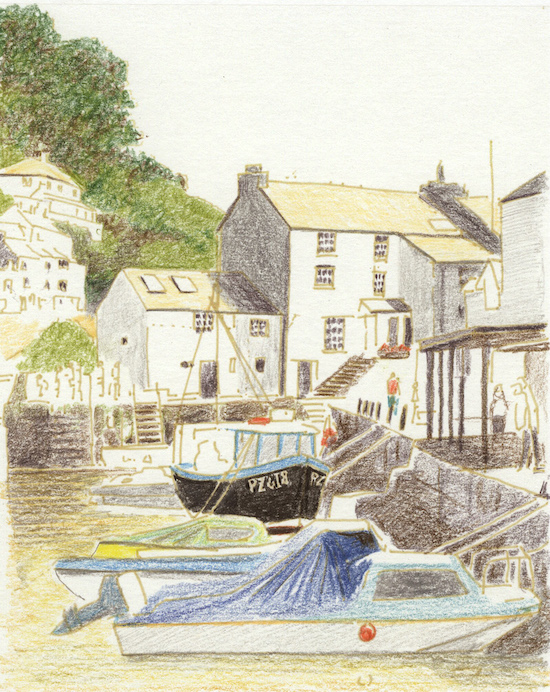
Adding water to your line and wash project
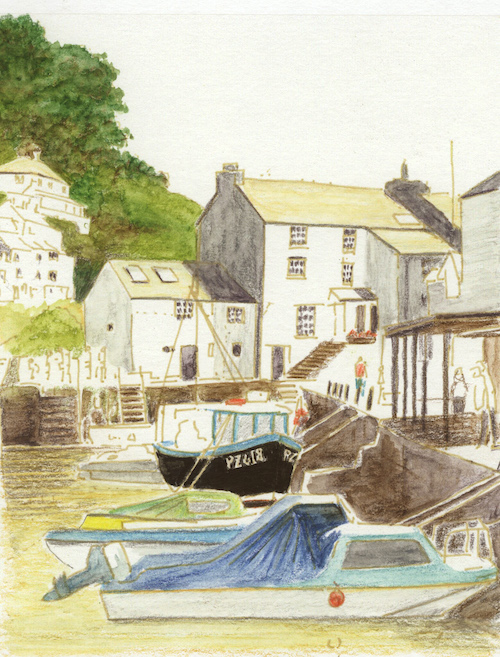
Once you have completed putting down all the layers of dry colour you need, you can introduce water. I have used a very fine nylon brush which has a good spring to it
For the trees I have worked a small scribble stroke with the damp brush so that colours are merged into a tree like appearance.
Moving down the greens I changed to a more even horizontal brush stroke for the grassed area.
Work down the picture, using a brush stroke appropriate to the surface you are representing. Water will be horizontal strokes with quite a dry brush, building surfaces may be horizontal or vertical strokes with a wetter brush etc. This results in a more even finish.
Keep a pad of kitchen roll handy to dry your brush and to mop off excessive colour from the paper. If you work immediately on the wet surface before it dries, you will be able to lift most of the colour if you need to. If you spot an area with colour which should have been white, erase the pencil before wetting it, as it's much easier that way.
The addition of water will intensify the colour and you will be able to smooth out some areas quite easily with the brush.
You will most probably need to go back into the picture once it has dried, and apply more detail and more colour depth with your pencils used ‘dry point’ to add the 'line' element of line and wash.
You might feel when you get to this point that you are happy and the picture could be regarded as finished.
You could well be correct BUT If you want to do more - see below.
Finishing off your line and wash drawing
We will now see what further development we can do to the picture once the surface has dried.
You will note that some areas have been left dry to date - the small windows and the numbers on the boat etc. Some areas are still to be completed.
Sharpen up your pencils and see what you can add in the way of further detail. The dark shadows under the roofs, the boat rigging, and some extra lines on the roofs to indicate rows of tiles could be added for instance.
I have used the same colours as previously plus a selection of other colours from the box to fine tune the picture. You may choose to add the line elements with a fineliner black pen, as in traditional line and wash paintings.
You will note that I have left the sky the white of the paper. I often do when I want the scene to stay sunlit as adding blue to the sky area effectively darkens the sky which is usually the lightest part of the picture. As with all personal preferences, there are exceptions as you will see in other exercises. Skies are among the difficult elements in Coloured Pencil and therefore I omit the sky in this early exercise.
There are further developments you could take with this picture and if you wish to work the picture in finer detail, I suggest that you take your own trace from the photo and work with a finer surfaced watercolour paper.
Good Luck !
If you really want to get a picture which is very detailed and exact to the photo, you will need a very accurate first drawing, and a lot of careful work with sharp points on your pencils. This will take time.
The original exercise took a mere 2 hours but the final result was not very satisfactory. This updated exercise takes between 5 and 6 hours.
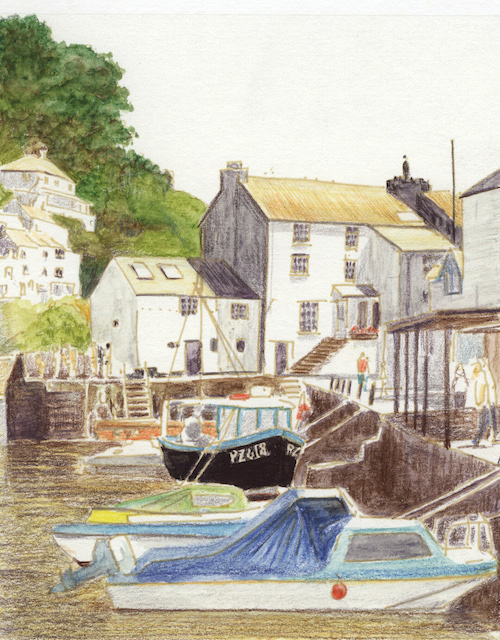
This version is the second edition of this scene and is more detailed than the previous one.
The picture development was the first line and wash landscape step by step that Peter created. He says that you should be able to do better than he did!
